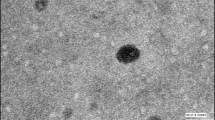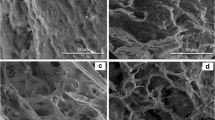Abstract
Anti-tuberculosis drug delivery has remained a challenge due to inconsistent bioavailability and inadequate sustained-release properties leading to treatment failure. To resolve these drawbacks, a lipopolysaccharide polyelectrolyte complex (PEC) encapsulated with rifampicin (RIF) (as the model drug) was fabricated, using the solvent injection technique (SIT), with soy lecithin (SLCT), and low-molecular-weight chitosan (LWCT). The average particle size and surface charge of RIF-loaded PEC particulates was 151.6 nm and + 33.0 nm, respectively, with noted decreased particle size and surface charge following increase in SLCT-LWCT mass ratio. Encapsulation efficiency (%EE) and drug-loading capacity (%LC) was 64.25% and 5.84%, respectively. Increase in SLCT-LWCT mass ratio significantly increased %EE with a marginal reduction in %LC. In vitro release studies showed a sustained-release profile for the PEC particulate tablet over 24 h (11.4% cumulative release) where the dominant release mechanism involved non-Fickian anomalous transport shifting towards super case II release as SLCT ratios increased (6.4% cumulative release). PEC-tablets prepared without SIT presented with rapid Fickian-diffusion-based drug release with up to 90% RIF release within 4 h. Ex vivo permeability studies revealed that lipopolysaccharide PEComplexation significantly increased the permeability of RIF by ~ 2-fold within the 8-h study period. These results suggest successful encapsulation of RIF within a PEC structure while imparting increased amorphic regions, as indicated by x-ray diffraction, for potential benefits in improved drug dissolution, bioavailability, and dosing.










Similar content being viewed by others
References
Costa A, Pinheiro M, Magalhães J, Ribeiro R, Seabra V, Reis S, et al. The formulation of nanomedicines for treating tuberculosis. Adv Drug Deliv Rev. 2016;102:102–15. https://doi.org/10.1016/j.addr.2016.04.012.
Rappuoli R, Aderem A. A 2020 vision for vaccines against HIV tuberculosis and malaria. Nature. 2011;473(7348):463–9. https://doi.org/10.1038/nature10124.
Sosnik A, Carcaboso ÁM, Glisoni RJ, Moretton MA, Chiappetta DA. New old challenges in tuberculosis: potentially effective nanotechnologies in drug delivery ☆. Adv Drug Deliv Rev. 2010;62(4–5):547–59. https://doi.org/10.1016/j.addr.2009.11.023.
Pinheiro M, Reis S. Liposomes as drug delivery systems for the treatment of TB. Review. Nanomedicine (Lond). 2011;6:1413–28.
Bachhav SS, Dighe VD, Kotak D, Devarajan PV. Erratum to ‘Rifampicin Lipid-Polymer hybrid nanoparticles (LIPOMER) for enhanced Peyer’s patch uptake’ (International Journal of Pharmaceutics (2017) 532 (612–622) (S0378517317309067) (10.1016/j.ijpharm.2017.09.040)). Int J Pharm. 2017;534(1–2):387–90. https://doi.org/10.1016/j.ijpharm.2017.09.040.
Petkar KC, Chavhan S, Kunda N, Saleem I, Somavarapu S, Taylor KMG, et al. Development of novel octanoyl chitosan nanoparticles for improved rifampicin pulmonary delivery: optimization by factorial design. AAPS PharmSciTech. 2018;19(4):1758–72. https://doi.org/10.1208/s12249-018-0972-9.
Patil J, Devi VK, Devi K, Sarasija S. A novel approach for lung delivery of rifampicin-loaded liposomes in dry powder form for the treatment of tuberculosis. Lung India. 2015;32(4):331 Available from: http://www.lungindia.com/text.asp?2015/32/4/331/159559. Accessed 19 Aug 2018.
El-ridy MS, Mostafa DM, Shehab A, Nasr EA, El-alim SA. Biological evaluation of pyrazinamide liposomes for treatment of Mycobacterium tuberculosis. Int J Pharm. 2007;330:82–8.
Devi N, Maji TK. Preparation and evaluation of gelatin/sodium carboxymethyl cellulose polyelectrolyte complex microparticles for controlled delivery of isoniazid. AAPS PharmSciTech. 2009;10(4):1412–9. https://doi.org/10.1208/s12249-009-9344-9.
Singh C, Koduri LVSK, Bhatt TD, Jhamb SS, Mishra V, Gill MS, et al. In vitro-in vivo evaluation of novel co-spray dried rifampicin phospholipid lipospheres for oral delivery. AAPS PharmSciTech. 2017;18(1):138–46. https://doi.org/10.1208/s12249-016-0491-5.
Ohashi K, Kabasawa T, Ozeki T, Okada H. One-step preparation of rifampicin/poly (lactic-co-glycolic acid) nanoparticle-containing mannitol microspheres using a four-fluid nozzle spray drier for inhalation therapy of tuberculosis. J Control Release. 2009;135(1):19–24. https://doi.org/10.1016/j.jconrel.2008.11.027.
Esmaeili F, Hosseini-nasr M, Rad-malekshahi M. Preparation and antibacterial activity evaluation of rifampicin-loaded poly lactide-co-glycolide nanoparticles. Nanomedicine. 2007;3:161–7.
Costa A, Sarmento B, Seabra V. European journal of pharmaceutical sciences mannose-functionalized solid lipid nanoparticles are effective in targeting alveolar macrophages. Eur J Pharm Sci. 2018;114(October 2017):103–13. https://doi.org/10.1016/j.ejps.2017.12.006.
Amarnath R, Munusamy MA, Kumar K, Rajan M. Targeted delivery of rifampicin to tuberculosis-infected macrophages: design, in-vitro, and in-vivo performance of rifampicin-loaded poly (ester amide) s nanocarriers. Int J Pharm. 2016;513(1–2):628–35. https://doi.org/10.1016/j.ijpharm.2016.09.080.
Rawal T, Mishra N, Jha A, Bhatt A, Tyagi RK, Panchal S, et al. Chitosan nanoparticles of gamma-Oryzanol: formulation, optimization, and in vivo evaluation of anti-hyperlipidemic activity. AAPS PharmSciTech. 2018;19(4):1894–907 Available from: http://www.ncbi.nlm.nih.gov/pubmed/29663289. Accessed 19 Aug 2018.
Nagpal K, Singh SK, Mishra DN. Chitosan nanoparticles: a promising system in novel drug delivery. Chem Pharm Bull (Tokyo). 2010;58(11):1423–30 Available from: https://www.jstage.jst.go.jp/article/cpb/58/11/58_11_1423/_article. Accessed 20 Aug 2018
Patidar A, Thakur DS, Kumar P, Verma J. A review on novel lipid based nanocarriers. Int J Pharm and Pharm Sci. 2010;2(4)30–35. Available from: https://innovareacademics.in/journal/ijpps/Vol2Issue4/806.pdf.
Salomon C, Goycoolea FM, Moerschbacher B. Recent trends in the development of chitosan-based drug delivery systems. AAPS PharmSciTech. 2017;18(4):933–5. https://doi.org/10.1208/s12249-017-0764-7.
Bhise KS, Dhumal RS, Chauhan B, Paradkar A, Kadam SS. Effect of oppositely charged polymer and dissolution medium on swelling, erosion, and drug release from chitosan matrices. AAPS PharmSciTech. 2007;8(2):Article 44.
Bawa P, Pillay V, Choonara YE, Claire L, Methaius V, Ndesendo K, et al. Research article a composite polyelectrolytic matrix for controlled oral drug delivery. 2011;12(1)227–238. https://doi.org/10.1208/s12249-010-9576-8.
Barbieri S, Sonvico F, Como C, Colombo G, Zani F, Buttini F, et al. Lecithin/chitosan controlled release nanopreparations of tamoxifen citrate: loading, enzyme-trigger release and cell uptake. J Control Release. 2013;167(3):276–83. https://doi.org/10.1016/j.jconrel.2013.02.009.
Pepic I, Hafner A, Lovric J. Lecithin/chitosan nanoparticles for transdermal delivery of melatonin. J Microencapsul. 2011;28(8):807–15.
Al-Remawi M, Elsayed A, Maghrabi I, Hamaidi M, Jaber N. Chitosan/lecithin liposomal nanovesicles as an oral insulin delivery system. Pharm Dev Technol. 2017;22(3):390–8.
Sahoo D, Sahoo S, Mohanty P, Sasmal S, Nayak PL. Chitosan: a new versatile bio-polymer for various applications. Des Monomers Polym. 2009;12(5):377–404.
Siyawamwaya M, Choonara YE, Bijukumar D, Kumar P, Du Toit LC, Pillay V. A review: overview of novel polyelectrolyte complexes as prospective drug bioavailability enhancers. Int J Polym Mater Polym Biomater. 2015;64(18):955–68.
Heinen C, Reuss S, Saaler-Reinhardt S, Langguth P. Mechanistic basis for unexpected bioavailability enhancement of polyelectrolyte complexes incorporating BCS class III drugs and carrageenans. Eur J Pharm Biopharm. 2013;85(1):26–33. https://doi.org/10.1016/j.ejpb.2013.03.010.
Cheow WS, Hadinoto K. Self-assembled amorphous drug-polyelectrolyte nanoparticle complex with enhanced dissolution rate and saturation solubility. J Colloid Interface Sci. 2012;367(1):518–26. https://doi.org/10.1016/j.jcis.2011.10.011.
Sonvico F, Cagnani A, Rossi A, Motta S, Di Bari MT, Cavatorta F, et al. Formation of self-organized nanoparticles by lecithin/chitosan ionic interaction. Int J Pharm. 2006;324:67–73.
Pawar H, Douroumis D, Boateng JS. Colloids and surfaces B: biointerfaces preparation and optimization of PMAA–chitosan–PEG nanoparticles for oral drug delivery. Colloids Surf B Biointerfaces. 2012;90:102–8. https://doi.org/10.1016/j.colsurfb.2011.10.005.
Ceccaldi C, Strandman S, Hui E, Montagnon E, Schmitt C, Hadj Henni A, et al. Validation and application of a nondestructive and contactless method for rheological evaluation of biomaterials. J Biomed Mater Res B Appl Biomater. 2017;105(8):2565–73.
Norris DA, Sinko PJ. Effect of size, surface charge, and hydrophobicity on the translocation of polystyrene microspheres through gastrointestinal mucin. J Appl Polym Sci. 1997;63(11):1481–92.
Liu M, Zhang J, Shan W, Huang Y. Developments of mucus penetrating nanoparticles. Asian J Pharm Sci. 2014;10(4):275–82. https://doi.org/10.1016/j.ajps.2014.12.007.
Jain S, Reddy CSK, Swami R, Kushwah V. Amphotericin B loaded chitosan nanoparticles: implication of bile salt stabilization on gastrointestinal stability, permeability and oral bioavailability. AAPS PharmSciTech. 2018;(10). https://doi.org/10.1208/s12249-018-1153-6.
Laridi R, Kheadr EE, Benech RO, Vuillemard JC, Lacroix C, Fliss I. Liposome encapsulated nisin Z: optimization, stability and release during milk fermentation. Int Dairy J. 2003;13(4):325–36.
Javed I, Hussain SZ, Ullah I, Khan I, Ateeq M, Shahnaz G, et al. Synthesis, characterization and evaluation of lecithin-based nanocarriers for the enhanced pharmacological and oral pharmacokinetic profile of amphotericin B. Journal of Materials Chemistry B. 2015;3(42):8359–65. https://doi.org/10.1039/c5tb01258a.
Cevher E, Taha MAM, Orlu M, Araman A. Evaluation of mechanical and mucoadhesive properties of clomiphene citrate gel formulations containing carbomers and their thiolated derivatives. Drug Delivery. 2008;15(1):57–67. https://doi.org/10.1080/10717540701829234
Chowdary KPR, Srinivasa Rao, Y. Mucoadhesive microspheres for controlled drug delivery. Biol Pharm Bull 2004;27(11):1717–24. https://doi.org/10.1248/bpb.27.1717
Smart J. The basics and underlying mechanisms of mucoadhesion. Adv Drug Deliv Rev. 2005;57(11):1556–68. https://doi.org/10.1016/j.addr.2005.07.001
Dora CP, Kushwah V, Katiyar SS, Kumar P, Pillay V, Suresh S, et al. Improved metabolic stability and therapeutic efficacy of a novel molecular gemcitabine phospholipid complex. Int J Pharm. 2017;530(1–2):113–27. https://doi.org/10.1016/j.ijpharm.2017.07.060.
Date PV, Samad A, Devarajan PV. Freeze thaw: a simple approach for prediction of optimal cryoprotectant for freeze drying. AAPS PharmSciTech. 2010;11(1):304–13. https://doi.org/10.1208/s12249-010-9382-3.
Singh C, Bhatt TD, Gill MS, Suresh S. Novel rifampicin-phospholipid complex for tubercular therapy: synthesis, physicochemical characterization and in-vivo evaluation. Int J Pharm. 2014;460(1–2):220–7. https://doi.org/10.1016/j.ijpharm.2013.10.043.
Alkhader E, Billa N, Roberts CJ. Mucoadhesive chitosan-pectinate nanoparticles for the delivery of curcumin to the colon. AAPS PharmSciTech. 2016;18(4):1009–18. https://doi.org/10.1208/s12249-016-0623-y.
Kumar S, Dutta PK, Koh J. International journal of biological macromolecules a physico-chemical and biological study of novel chitosan—chloroquinoline derivative for biomedical applications. Int J Biol Macromol. 2011;49(3):356–61. https://doi.org/10.1016/j.ijbiomac.2011.05.017.
Formariz TP, Chiavacci LA, Sarmento VH V, Franzini CM, Jr AAS-, Scarpa M V, et al. Structural changes of biocompatible neutral microemulsions stabilized by mixed surfactant containing soya phosphatidylcholine and their relationship with doxorubicin release. Colloids Surf B Biointerfaces. 2008;63:287–95. https://doi.org/10.1016/j.colsurfb.2007.12.021.
Cheng W, Luo Z, Li L, Fu X. Preparation and characterization of debranched-starch/phosphatidylcholine inclusion complexes. J Agric Food Chem. 2015;63(2):634–41. https://doi.org/10.1021/jf504133c.
Celia C, Trapasso E, Cosco D, Paolino D, Fresta M. Turbiscan lab® expert analysis of the stability of Ethosomes® and ultradeformable liposomes containing a bilayer fluidizing agent. Colloids Surf B Biointerfaces. 2009;72(1):155–60.
Gan LJ, Wang XY, Yang D, Zhang H, Shin JA, Hong ST, et al. Emulsifying properties of lecithin containing different fatty acids obtained by immobilized lecitase ultra-catalyzed reaction. J Am Oil Chem Soc. 2014;91(4):579–90.
Hörter D, Dressman JB. Influence of physicochemical properties on dissolution of drugs in the gastrointestinal tract. Adv Drug Deliv Rev. 1997;25(1):3–14.
Vårum KM, Myhr MM, Hjerde RJN, Smidsrød O. In vitro degradation rates of partially N-acetylated chitosans in human serum. Carbohydr Res. 1997;299(1–2):99–101. https://doi.org/10.1016/s0008-6215(96)00332-1.
Agoram B, Woltosz WS, Bolger MB. Predicting the impact of physiological and biochemical processes on oral drug bioavailability. Adv Drug Deliv Rev. 2001;50. S41–S67. https://doi.org/10.1016/s0169-409x(01)00179-x.
Eduardo J, Ballerini M, Chiann C, Nella M. Effect of pH, mucin and bovine serum on rifampicin permeability through Caco-2 cells. Biopharm Drug Dispos. 2012;323(August):316–23. https://doi.org/10.1002/bdd.1802.
Mariappan TT, Singh S. Positioning of rifampicin in the biopharmaceutics classification system (BCS). Clin Res Regul Aff. 2006;23(1):1–10. https://doi.org/10.1080/10601330500533990.
Collett A, Tanianis-hughes J, Warhurst G. Rapid induction of P-glycoprotein expression by high permeability compounds in colonic cells in vitro: a possible source of transporter mediated drug interactions. Biochem Pharmacol. 2004;68:783–90. https://doi.org/10.1016/j.bcp.2004.05.006.
Buckley ST, Fischer SM, Fricker G, Brandl M. European journal of pharmaceutical sciences in vitro models to evaluate the permeability of poorly soluble drug entities: challenges and perspectives. Eur J Pharm Sci. 2012;45(3):235–50. https://doi.org/10.1016/j.ejps.2011.12.007.
Hamalainen M, Frostell-Karlsson A. Predicting the intestinal absorption potential of hits and leads. Drug Discov Today Technol. 2004;1(4):397–405. https://doi.org/10.1016/j.ddtec.2004.09.004.
Danaei M, Dehghankhold M, Ataei S, Hasanzadeh Davarani F, Javanmard R, Dokhani A, et al. Impact of particle size and polydispersity index on the clinical applications of lipidic nanocarrier systems. Pharmaceutics. 2018;10(2):1–17.
Were LM, Bruce BD, Davidson PM, Weiss J. Size, stability, and entrapment efficiency of phospholipid nanocapsules containing polypeptide antimicrobials. J Agric Food Chem. 2003;51(27):8073–9.
Acknowledgments
This work was supported by the National Research Foundation (NRF) of South Africa.
Author information
Authors and Affiliations
Corresponding author
Ethics declarations
Disclosure
The authors declare that they have no conflicts of interest.
Additional information
Guest Editor: Sanyog Jain
Publisher’s Note
Springer Nature remains neutral with regard to jurisdictional claims in published maps and institutional affiliations.
Rights and permissions
About this article
Cite this article
Sumaila, M., Ramburrun, P., Kumar, P. et al. Lipopolysaccharide Polyelectrolyte Complex for Oral Delivery of an Anti-tubercular Drug. AAPS PharmSciTech 20, 107 (2019). https://doi.org/10.1208/s12249-019-1310-6
Received:
Accepted:
Published:
DOI: https://doi.org/10.1208/s12249-019-1310-6




